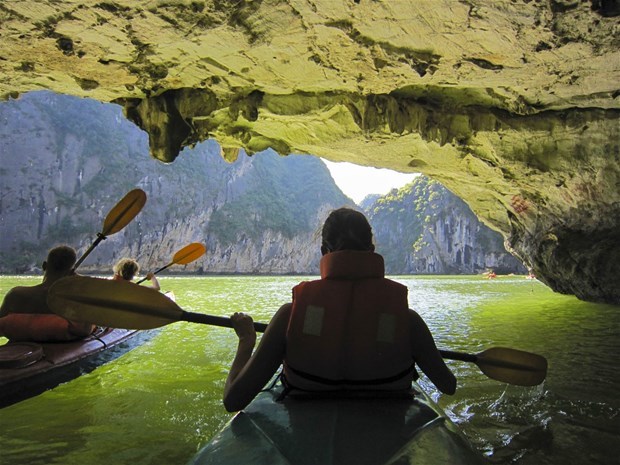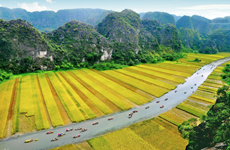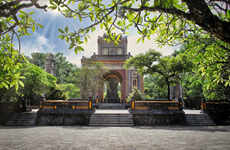Ha Long Bay - Giant 'watercolour painting' in the Gulf of Tonkin
 Ha Long Bay seen from above (Photo: Getty)
Ha Long Bay seen from above (Photo: Getty)
Hanoi (VNA) - Ha Long Bay has always been considered a leading tourist destination in Vietnam with a harmonious natural landscape. The majestic scenery of Ha Long Bay has helped it to be recognised as a World Natural Heritage by the United Nations Educational, Scientific and Cultural Organisation (UNESCO).
Ha Long Bay has been also listed by many magazines, websites and tourism organisations around the world. Recently, Ha Long Bay has been named among the 50 most beautiful natural wonders in the world by Insider, a US-based magazine.
Previously, Ha Long Bay was on numerous lists such as the 20 best backpacker destinations in 2020 (voted by the US tourism service platform Hostelworld) or the top 5 most attractive tourist destinations in Asia (voted by Hoppa airport transition website).
Located in the Gulf of Tonkin, Ha Long Bay includes thousands of islands and islets, forming a spectacular seascape of limestone pillars. Seen from above, it is a mighty and unique artwork by nature with thousands of islands rising from the emerald water.
Ha Long Bay, literally “descending dragon bay”, spans 1,553 square kilometres and includes 1,969 islands of various sizes. The limestone in the bay has gone through 500 million years of formation in different conditions and environments.
The long evolution and erosion of the bay has produced pyramid-shaped karst towers that gave the bay its unique beauty.
The bay accommodates temperate ecosystems suitable for many species of marine animals, in addition to its great cultural and historical value.
Scientists have shown that Ha Long was inhabited by three successive cultures between 3,000 and 18,000 years ago: the Soi Nhu, Cai Beo and Ha Long groups
On December 17, 1994, UNESCO designated the bay a World Heritage site of globally outstanding value in terms of natural landscape. The recognition was extended in 2000, and in 2011 Ha Long Bay outranked 261 other landscapes from all over the world and was voted one of the seven new natural wonders of the world in 2012.
The core zone of Ha Long Bay, which was designated by UNESCO as World Heritage Site, incorporates 434 square kilometres with 775 islands, delimited by three points: Dau Go Island on the west, Ba Ham Lake on the south and Cong Tay Island on the east.
 Visitors can enjoy the Ha Long Bay’s landscape by kayak. (Photo: Getty)
Visitors can enjoy the Ha Long Bay’s landscape by kayak. (Photo: Getty)
The recognition acknowledges the bay’s exceptional rock cave and limestone mountain system which took millions of years to form, as well as its outstanding biodiversity. The geo-diversity of the environment has created biodiversity, including a tropical evergreen biosystem, oceanic and sea biosystem.
Scientists identified more than 500 species of high-level plants in the bay, which spans 1,553km2 and includes 1,969 islands of various sizes. Half of the plants have medicinal properties and could potentially be used as medicine. Experts also observed 66 species of amphibians and reptiles, 77 species of bird and 22 species of mammals.
Over 570 species of seabed creatures, around 180 coral species, over 150 species of fish, nearly 150 species of seaweed and sea grass, and 19 species of aquatic plants were identified in the bay and neighbouring Bai Tu Long Bay and Cat Ba Bay.
With outstanding values in terms of landscape and geology and geomorphology, Ha Long Bay boasts favourable conditions to develop tourism economy with various forms./.
 Ha Long Bay is famous for large caves. (Photo: Shutterstock)
Ha Long Bay is famous for large caves. (Photo: Shutterstock)












